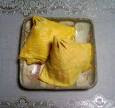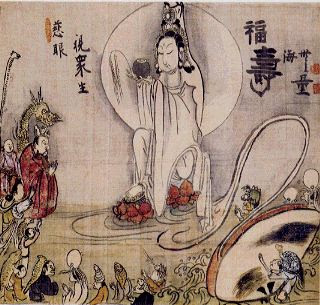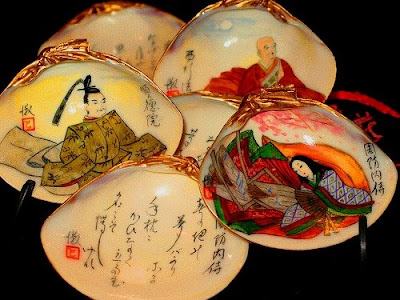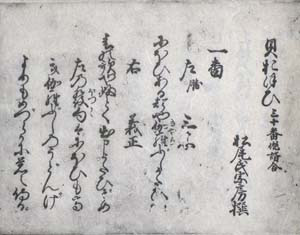. Famous Places of Edo .
::::::::::::::::::::::::::::::::::::::::::::::::::::::::::::::::::::::::::::::::::::::::::::::::::::
Clamshell (hamaguri)
***** Location: Japan
***** Season: All spring
***** Category: Humanity
*****************************
Explanation
clamshell, hard clam, hamaguri 蛤 (はまぐり)
Meretrix lusoria. Venus clam, clam shell
Common orient clam
hodgepodge with clamshells, hamaguri nabe 蛤鍋(はまなべ)
steamed hamaguri, mushi hamaguri 蒸蛤(むしはまぐり)
hamaguri broth, hamatsuyu 蛤つゆ(はまつゆ)
grilled hamaguri, yaki hamaguri 焼蛤(やきはまぐり)
suhamaguri 洲蛤(すはまぐり)
hamaguri with vinegar, su hamaguri 酢蛤(すはまぐり)

Heat shimmers (kageroo), also called
"shell tower" kai yagura 貝櫓, kairoo 貝楼
People of old believed that a clam shell (hamaguri) would cough up air and produce a tower in the air. Other stories say it was a huge frog who belched.
Heat shimmers, KIGO
yakihamaguri, grilled right by the seaside, are a favorite with the Japanese. I remmeber the many stalls at Enoshima near Kamakura.
. . . CLICK here for Photos !
:::::::::::::::::::::::::::::::::::::::::::::::::::::::::::::::::::::::::::::::::::::::::::::::::::
:::::::::::::::::::::::::::::::::::::::::::::::::::::::::::::::::::::::::::::::::::::::::::::::::::
other types are
choosen hamaguri チョウセンハマグリ Meretrix lamarcki
"Korean clam"
shina hamaguri シナハマグリ Meretrix petechialis
"Chinese clam"
.................................................................................
Some dishes with this clam
sakamushi ハマグリのさかむし, ハマグリの酒蒸し
simmered in ricewine
. . . CLICK here for Photos !
Speciality of Hyogo, Kinosaki Onsen 城崎温泉(きのさきおんせん)
:::::::::::::::::::::::::::::::::::::::::::::::::::::::::::::::::::::::::::::::::::::::::::::::::::::
時雨はまぐり, 時雨蛤 shigure hamaguri,
clamshells in sweet syrup
speciality of Mie prefecture
. . . CLICK here for Photos !
This refers back to the famous battle of Sekigahara (1600), near Ogaki castle, where the fishermen of Kuwana gave some clams to Tokugawa Ieyasu.
The clams are harvested out of the sand and then left for a while in a bucket of plain water to spit out the sand they still have in their body. They are then boiled in this water with shredded ginger roots and then cooled. Next they are simmered in special soy sauce from Ise (tamari shooyu たまり醤油) and flavored with sweet mizuame syrup.
see the haiku below !
. Sekigahara 関ヶ原 .
yakihamaguri 焼蛤 grilled Hamaguri, baked clams
The clams of Kuwana have quite a soft texture and a rich flavor. Until our day they are served in many restaurants in the city.

桑名 四日市へ三里八丁 - 3 ri and 8 cho to Yokkaichi
(about 12.7 km from Kuwana to Yokkaichi)
葛飾北斎 Katsushika Hokusai
Before starting the walk, people enjoyed some Hamaguri.
They were grilled in a fire with pine cones to add flavor, but it also produced a lot of ashes.
On the image you can see one lady fanning the fire, turning her face the other side to avoid the smoke.

歌川広重 Hiroshige - Kuwana
Detail of grilling the Hamaguri in a roadside stall.
................................................................................
sushi looking like hamaguri, hamagurizushi
はまぐり寿司

Served for the Doll Festival (hina matsuri) Peach Festival, Girl's Festival
A thin omelette is folded like a clam and filled with sushi rice and some other ingredients.
http://www.justhungry.com/shell-shaped-sushi-hamaguri-zushi-girls-festival
wanko hamaguri わんこハマグリ venus clamshells to eat in fast competition
wankosoba, eating buckwheat in this way, is famous in Morioka. But this way of eating hamaguri is a speciality of the restaurant Kuwana 桑名 on Ishigaki Island 石垣島.
. . . CLICK here for Photos !
*****************************
Worldwide use
Venusmuschel
*****************************
Things found on the way

Painting by Hakuin
Hamaguri Kannon 蛤観音, 蛤蜊
One of the 33 incarnations of Kannon Bosatsu.
The incarnation Nr. 25 is called Hamaguri. When emperor Bunso of China in the year 831 wanted to eat a clamshell, it transfigured itself into a Kannon Bosatsu.
25. In einer Venusmuschel. (Koori, Hamaguri)
Als der chinesische Kaiser Bunsoo im Jahre 831 eine Venusmuschel (hamaguri) essen wollte, verwandelte sich diese in eine Kannon.
Kannon with Fish Basket, Gyoran Kannon
魚籃観音(ぎょらんかんのん)
:::::::::::::::::::::::::::::::::::::::::::::::::::::::::::::::::::::::::::::::::::::::::::::::::::::
Dajare, play of words of the Edo period
sono te wa kuwana no yaki-hamaguri
その手は桑名の焼きはまぐり >
「その手は桑名い」 > 「その手は食わない」
Puns, dajare 駄洒落 ダジャレ, だじゃれ Daruma Museum
::::::::::::::::::::::::::::::::::::::::::::::::::::::::::::::::::::::::::::::::::::::::::::::::::::::::::
. Famous Places of Edo .
Hamagurichoo 蛤町 Hamaguri Cho district
former 深川蛤町 一・二丁目 Fukagawa Hamaguri cho first and second district until 1911
now 江東区永代二丁目、門前仲町一・二丁目 Koto ward, Eitai second district, Monzennaka cho first and second district.
This district used to be on the shore and many fishermen lived here, looking for Hamaguri and fish. Eventually the Edo government reclaimed the land around 1600 and the third Shogun Iemitsu, when visiting the area, gave the name Hamaguri to the place.
Many fish dealers soon came to live here too and the sound of vendors could be heard.
Hamaguribori 蛤堀 Hamaguri moat

The famous explorer Mamiya Rinzō 間宮林蔵 Mamiya Rinzo (1775 - 1844) spent his last years in Hamaguri.
- - - More in the WIKIPEDIA !
:::::::::::::::::::::::::::::::::::::::::::::::::::::::::::::::::::::::::::::::::::::::::::::::::::::

Kai-awase game with Daruma San
Kai-Awase clam shell game / More Photos
貝合; 貝合わせ; 貝合せ, かいあわせ
a game popular since the Heian period.

with poems of the Heian period and their poets
kigo for all spring
kaiawase, kai-awase 貝合 (かいあわせ) clam shell game
Spiel mit Muscheln
..... kai ooi 貝覆(かいおおい)container for the clam shell game
..... kaioke, kai oke 貝桶(かいおけ)container
Most were beautifully decorated.
. . . CLICK here for Photos !
- quote -
kaiawase 貝合
Also called kaiooi 貝覆. A shell-matching game played originally by nobles in the Heian period. A half clam shell was decorated and placed outer side-up. The matching half of the design was painted on other half shells and they were turned over one by one by players competing to match pairs. A poem or miniature painting was added inside each shell in order to facilitate matching, with the first part of a 32-syllable poem written on one half and the latter part written on its mate, while both halves were detailed with an identical motif.
The most popular subjects are flowers and episodes from GENJI MONOGATARI 源氏物語 (The Tale of Genji). The Hayashibara 林原 Museum's (Okayama prefecture) set of 180 pairs of illustrations from the GENJI MONOGATARI is a beautiful example from the Edo period.
Sets of kaiawase were often part of a bridal trousseau and this one is recorded as being brought by the bride of Ikeda Mitsumasa 池田光政 in 1628. The minute paintings are in the traditional *yamato-e やまと絵 style characterized by lavish gilt backgrounds. Hexagonal boxes *kaioke 貝桶 used for storing pairs of shells especially in the Edo period, were often decorated in the *makie 蒔絵 lacquer technique using much gold or silver.
- source : JAANUS -
. The Heian Period 平安時代 Heian jidai (794 - 1185) .
- Introduction -
. kai zaiku 貝細工 sea shell craft .
.................................................................................

Kai-ooi, Kai-Oi, Kaioi 貝おほひ Seashell Game
Book by Matsuo Basho, 1672
The Shell Game,
collected poems by Basho and 32 poets, edited by Basho, and dedicated to Ueno Tenjingu shrine 上野天神宮 in Iga.
This book is about a haiku contest in thirty rounds (sanjuuban ku awase). Pairs of two haiku, each one by a different poet, are matched and Basho discusses them. He also contributed two haiku, see below. His critical comments and the way he refereed the matches are most interesting. He seems to be a man of brilliant wit and colorful imagination, who had a great knowledge of popular songs, fashionable expressions, and the new ways of the world in the Edo period. This book was written in the light spirit of HAI kai.
Two haiku by Basho from this book:
きてもみよ甚兵が羽織花衣
kite mo miyo jinbe ga haori hanagoromo
(kite mo miyo : This is a double play with words, come and see, or come and wear this jinbei when looking for cherry blossoms.)
come and look!
put on a Jinbei robe
and admire the blossoms
Tr. Makoto Ueda
女男鹿や毛に毛がそろうて毛むつかし
meoto jika ya ke ni ke ga soroute ke muzukashi
husband and wife deer -
their hair is all the same
but sometimes it's different
寛文12年, Basho at 29 years
(This is a pun with ke muzukashi、to be hard to get along with.)
. light summer suit with short legs 甚兵衛 jinbei .
. Matsuo Basho 松尾芭蕉 - Archives of the WKD .
quote
The Seashell Game (貝おほひ, Kai Ōi? is a 1672 anthology compiled by Japanese poet Matsuo Bashō, in which each haiku is followed by critical commentary he made as referee for a haiku contest.It is Bashō's earliest known book, and the only book he published in his own name. The work contains 60 haiku by 36 poets, including two by Bashō himself.
The format is based on a children's game where two seashells were placed side by side and compared. Bashō compares pairs of haiku by different authors in the same manner in the book. According to scholar Sam Hamill, The Seashell Game shows Bashō "to be witty, deeply knowledgeable, and rather light-hearted."
Bashō compares the following pair of verses on the topic of colourful autumn leaves:
How like it is to
A midwife's right hand–
Crimson maple leaf!
—Sanboku
"I haven't crimsoned.
Come and look!" So says the dew
On an oak branch
—Dasoku
In his commentary, Bashō declares that the first poem "ranks thousands of leagues" above the second.
© More in the WIKIPEDIA !
:::::::::::::::::::::::::::::::::::::::::::::::::::::::::::::::::::::::::::::::::::::::::::::::::::::
Clam Go Stones from Hyuga Town 日向はまぐり碁石
Hyuga hamaguri Go-ishi

Hyuga City in Miyazaki Prefecture, Japan, is recognized as one of the most important clam shell Go stone producers in the World. Until the early 1900's clams from the Hitachi, Mikawa, and Kuwana areas of Japan were thought of as being the best for the production of high quality clam shell Go stones. However, around this time, a travelling salesman from Toyama Prefecture passed through Hyuga and took note of the quality of Hyuga "hamaguri" clam shells. The Hyuga clams had shells even thicker and denser than those coming from the other areas. The Hyuga clams were taken to Osaka and Hyuga very quickly gained a reputation as being the source of material for first class stones.
Nearly a century has passed since then, and those three areas, once known as leaders in the Go stone industry, have disappeared. Only Hyuga remains; constantly striving to maintain, and improve upon, traditional techniques. Hyuga takes pride in being the best and only home of clam shell Go stones.
However, even Okuragahama in Hyuga, the home of the famous Hyuga hamaguri clams, is suffering a scarcity of clam shells. So much so that Go stones made in Hyuga from real Hyuga hamaguri shells have reached near legendary status. While stones produced in Hyuga are crafted using time-honored traditional techniques, most of the shells themselves are now imported from Mexico. Despite the shells' immigrant status, the stones so produced proudly bear the name "Hyuga Tokusei Goishi," "Hyuga-Crafted Clam Go Stones," and are loved and sought after by Go fans the World over.
source : www.kurokigoishi.co.jp
Go game, Igo 囲碁 topic for haiku
:::::::::::::::::::::::::::::::::::::::::::::::::::::::::::::::::::::::::::::::::::::::::::::::::::::
The rebellion at the Hamaguri Gate
(蛤御門の変 Hamaguri gomon no Hen) of the Imperial Palace in Kyōto took place on August 20, 1864 and reflected the discontent of pro-imperial and anti-alien groups. During the bloody crushing of the rebellion, the leading Chōshū clan was held responsible for it.
During the incident, the Aizu and Satsuma domains led the defense of the Imperial palace.
© More in the WIKIPEDIA !
:::::::::::::::::::::::::::::::::::::::::::::::::::::::::::::::::::::::::::::::::::::::::::::::::::::
Umugaihime 蛤貝比売命(うむがいひめ)
Umugaihime is a personification of the
cherry-stone clam (hamaguri),
. WASHOKU
Umugaihime and Kisagaihime / akagai ark-shell clams
*****************************
HAIKU
At the end of his journey,
. Oku no Hosomichi 奥の細道 .
Basho wrote this haiku in Ogaki town:
蛤のふたみにわかれ行く秋ぞ
hamaguri no futami ni wakare yuku aki zo
the clamshell
divides in two and leaves
this autumn . . .
(like) a clamshell
divided in two we depart now
into this autumn . . .
The kakenotoba word with a double meaning here is
futami 二身 - 蓋身 two bodies
This expression can be interpreted in many ways.
Here Basho thinks of his physical separation from Sora, who has been his faithful companion on the road for so many weeks.
Basho also thinks of the body of his elder brother Matsuo Hanzaemon 松尾半左衛門, who had been home keeping the Basho family estate ever since Basho left him, more than 24 years ago.
His brother loved hamaguri clamshells.
There are also translations which interpret
FUTAMI as a place name in Ise 伊勢の二見.
Dividing like clam
and shell, I leave for Futami -
Autumn
. Futami Okitama Jinja 二見興玉神社 - Ise .
and meoto iwa (“husband and wife rocks,” or “wedded rocks”)
- English Reference -

. Matsuo Basho - Family Ties .
His Wife ? Jutei-Ni 寿貞尼
His Son ? Jirobei 二郎兵衛
His nephew Tooin 桃印 Toin
:::::::::::::::::::::::::::::::::::::::::::::::::::::::::::::::::::::::::::::::::::::::::::::::::::::
Kobayashi Issa in Kamakura
蛤や在鎌倉の雁鴎
hamaguri ya zai-kamakura no kari kamome
O clams
meet the geese and gulls
of Greater Kamakura!
Tr. David Lanoue
Kamakura and Haiku
.................................................................................
More by Kobayashi Issa
はまぐりの芥(あくた)を吐かす月夜かな
hamaguri no akuta o hakasu tsukiyo kana
蛤の芥を吐する月夜かな
hamaguri no gomi o hakasuru tsuki yo kana
the clam vomits
mud...
a moonlit night
Tr. David Lanoue
clams in the bucket
left to spit out the mud
in the moonlit night
Tr. Makoto Ueda
moonlit night - -
clams left to spit out
the mud
paraverse by Gabi Greve
It was customary to have a bowl of clam soup on the night of the full moon.
Here are two haiku by Yanagidaru:
はまぐりは月見と聞いて死ぬ覚悟
hamaguri wa tsukimi to kiite shinu kakugo
when the clams
hear about the full moon night
they get ready to die
はまぐりのしぐれ焼き場へ籠で来る
hamaguri no shigureyakiba e kago de kuru
to the place
where they grill clams in sweet syrup
they come in palanquins
Haifuu Yanagidaru 誹風柳多留 (Edo period haiku poet)
*****************************
Related words
***** WASHOKU : INGREDIENTS
***** WASHOKU : FISH and SEAFOOD
WASHOKU : Shells, mussels and their cuisine
:::::::::::::::::::::::::::::::::::::::::::::::::::::::::::::::::::::::::::::::::::::::::::::::::::::
[ . BACK to WORLDKIGO . TOP . ]
[ . BACK to DARUMA MUSEUM TOP . ]
- #hamaguri #kuwana -
:::::::::::::::::::::::::::::::::::::::::::::::::::::::::::::::::::::::::::::::::::::::::::::::::::::




10 comments:
Gabi san 久しぶりに鎌倉を満喫しました。
有難うございました。
I have enjoyed Kamakura tour on your site.
Thank you so much.
作雄。
Dear Gabi,
I have to say I much prefer your translation:
moonlit night --
clams left to spit out
the mud
Alan
(translating haiku forum)
kaigara o haite aruku ya sato no ume
貝殻をはいて歩くや里の梅
walking along
sweeping shells...
plum blossom village
Kobayashi Issa
(Tr. David Lanoue)
.
hamaguri no ikeru kai are toshi no kure
clams survived
and became valuable
year's end
Tr. Reichhold
[Reichhold's comment:
"The wordplay comes with 'kai', which can mean either 'worthy' or 'valuable' and 'shell' or shellfish'. The clams have survived
because they have hard shells, and they have become valuable at the end of the year for the traditional clam soup."
hamaguri no futami ni wakare yuku aki zo
.
t'is autumn -
we part from each other like
two halves of a clam shell
autumn is here -
taking leave from one another
like parts of clam shells
autumn now -
as clam shells wrenched apart
we split up
autumn -
each our seperate ways
like clamshells' halves
as clamshell asunder
each body taking leave
in autumn
sprite
ほととぎすなくや皐月のあやめ草
あやめも知らぬ恋もするかな
hototogisu naku ya satsuki no ayamegusa
ayame mo shiranu koi mo suru kana
In the month of June
When the little cuckoo cries,
Sweet flag everywhere:
Oh, sweet tangle of my love
That knows no weave or pattern!
Edwin A. Cranston
Kokinshu, yomibito shirazu 古今集 よみびとしらず
.
Oku no Hosomichi 奥の細道 - おくのほそ道
Kai-awase with 23 pairs
Matsuo Basho
In most Yokai stories, a female animal becomes the wife of a human
- irui nyooboo 異類女房 daughter-in-law of another kind .
hamaguri nyoobo 蛤女房 hamaguri clam wife (photo)
.
https://edoflourishing.blogspot.com/2013/03/iruikon-marriage.html
.
Legend from Shinagawa, Tokyo
hamaguri 蛤,Jizo 地蔵
At the beach of 洲崎浜 Suzakihama in Shinagawa, in the eleventh lunar month, some fishermen were peeling clam shells, when they found one with a very small golden statue of Jizo Bosatsu inside,
.
https://edoflourishing.blogspot.com/2018/07/shinagawa-ward.html
.
Monzennakachoo, Monzen-Nakachō 門前仲町 Monzen-Nakacho district
江東区 Koto ward, 門前仲町一丁目 . 門前仲町二丁目 first and second sub-district
lit. a town at the gate of a temple or shrine.
.
https://edoflourishing.blogspot.com/2019/06/monzen-nakacho-district-koto.html
.
Post a Comment